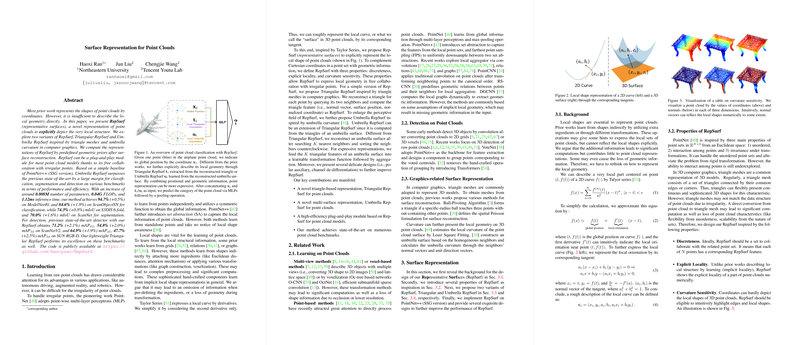Surface Representation for Point Clouds
The work by Ran et al. addresses a fundamental challenge in 3D point cloud processing—effectively representing the local geometric structure. Traditional methods often rely heavily on point coordinates, yet these prove insufficient for capturing intricate local shapes. The authors introduce RepSurf, an innovative approach aimed at alleviating these limitations through discrete surface representation. This method leverages properties borrowed from triangle meshes and umbrella curvature to explicitly depict local structures, offering a robust enhancement to existing point cloud models.
Contributions and Methodology
The paper primarily introduces two variants of Representative Surfaces (RepSurf): Triangular RepSurf and Umbrella RepSurf.
- Triangular RepSurf: Inspired by triangle meshes, this method reconstructs a triangle for each point by querying two neighbors. The triangle's geometric features such as normal vector and surface position are utilized for an enriched representation.
- Umbrella RepSurf: Extending beyond simple triangulation, this variant employs umbrella curvature concepts. By reconstructing an "umbrella surface" using multiple neighboring points, this method captures broader local geometry and allows for more comprehensive feature learning.
Both methods are posited as "plug-and-play" modules, seamlessly integrating into existing models such as PointNet++.
Experimental Results
The authors evaluate these techniques across several benchmarks. The results reveal substantive improvements in accuracy and efficiency over previous state-of-the-art methods. For instance, when applied to ModelNet40, RepSurf-U attains an accuracy of 94.7%, a notable 0.5% increase over the best prior results.
- Classification: On ModelNet40 and ScanObjectNN, the proposed methods outperform existing models, achieving gains of up to 6.7 percentage points in overall accuracy with a marginal increase in computational cost.
- Segmentation: RepSurf-U demonstrates superior performance on the S3DIS and ScanNet datasets. On S3DIS 6-fold, it outstrips prior methods by 0.8% in mIoU.
- Detection: Integrating RepSurf into GroupFree 3D detection models enhances performance on ScanNetV2 and SUN RGB-D, with increases of up to 2.1 percentage points in [email protected].
Implications and Future Directions
This approach provides a refined mechanism for leveraging local geometric structures in point cloud data, potentially influencing a wide array of applications from robotics to autonomous vehicles. The methodological simplicity and compatibility with existing systems underscore its practical viability.
Future research could delve into the exploration of RepSurf's impact on larger-scale and more complex datasets. Additionally, addressing challenges related to point cloud noise and environmental variability would bolster the robustness and adaptability of these methods in dynamic real-world scenarios.
The authors' work sets a significant milestone in representing complex local structures within point clouds, fostering potential advancements across computational geometry and related domains.
